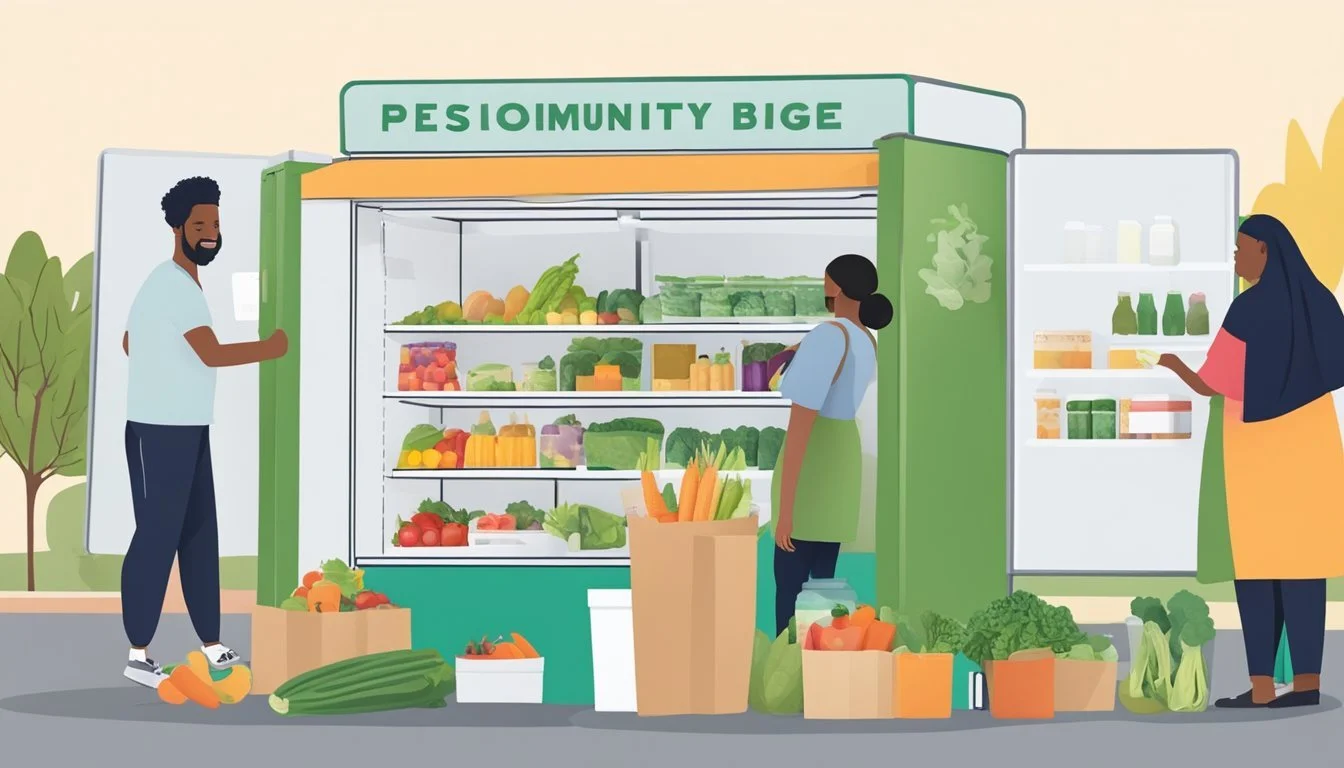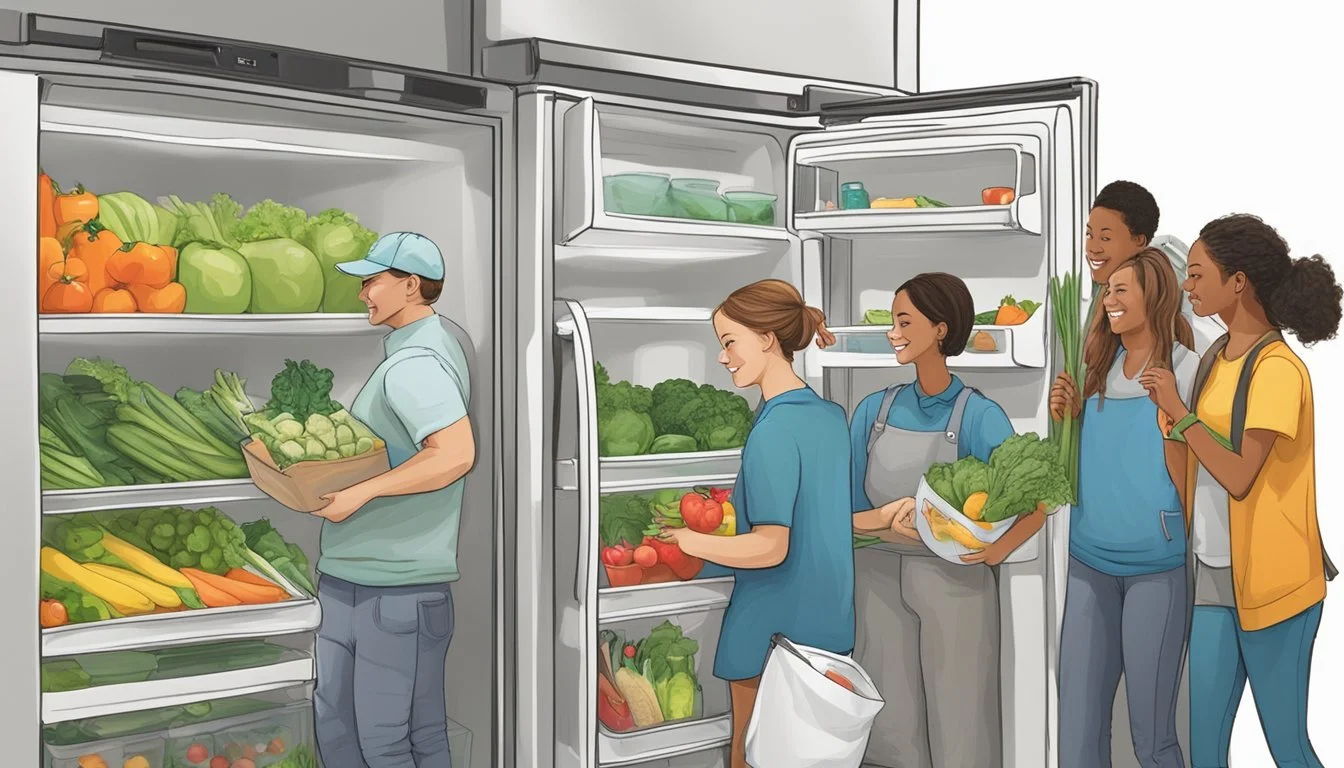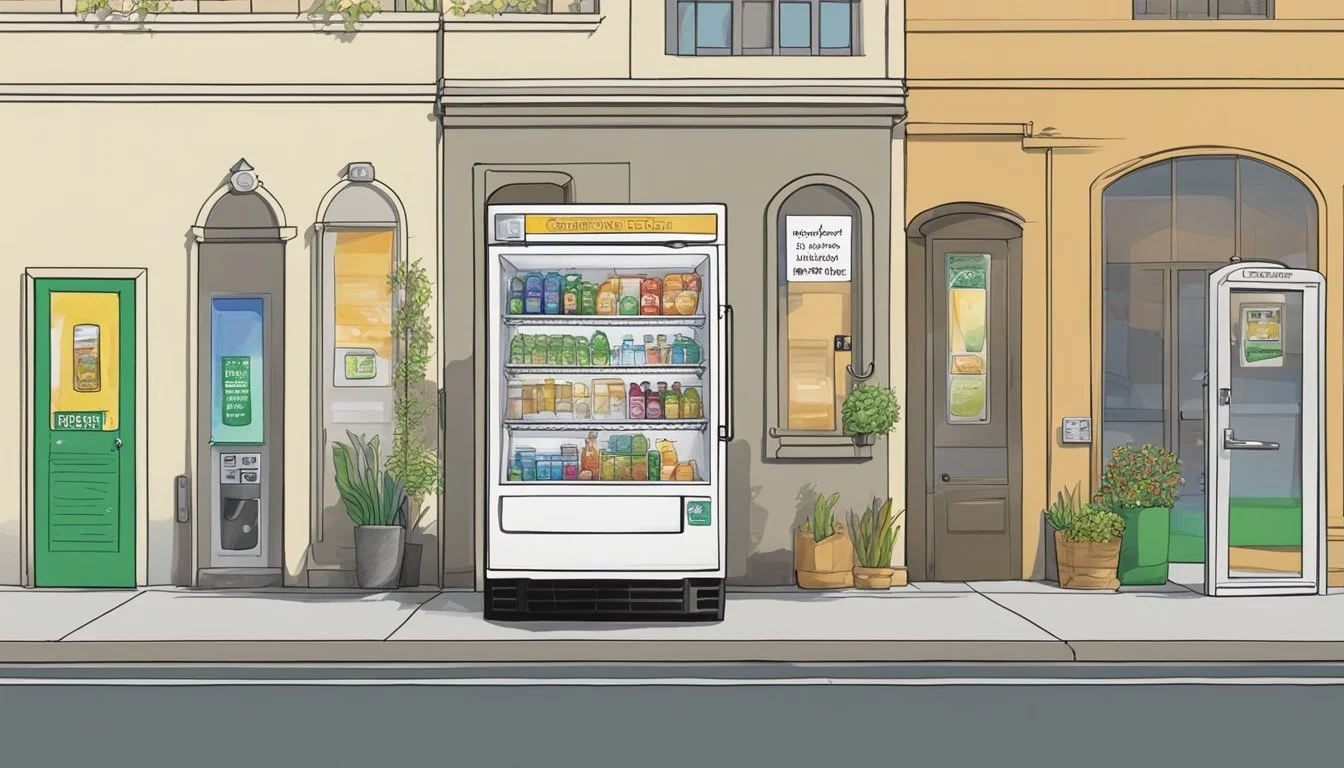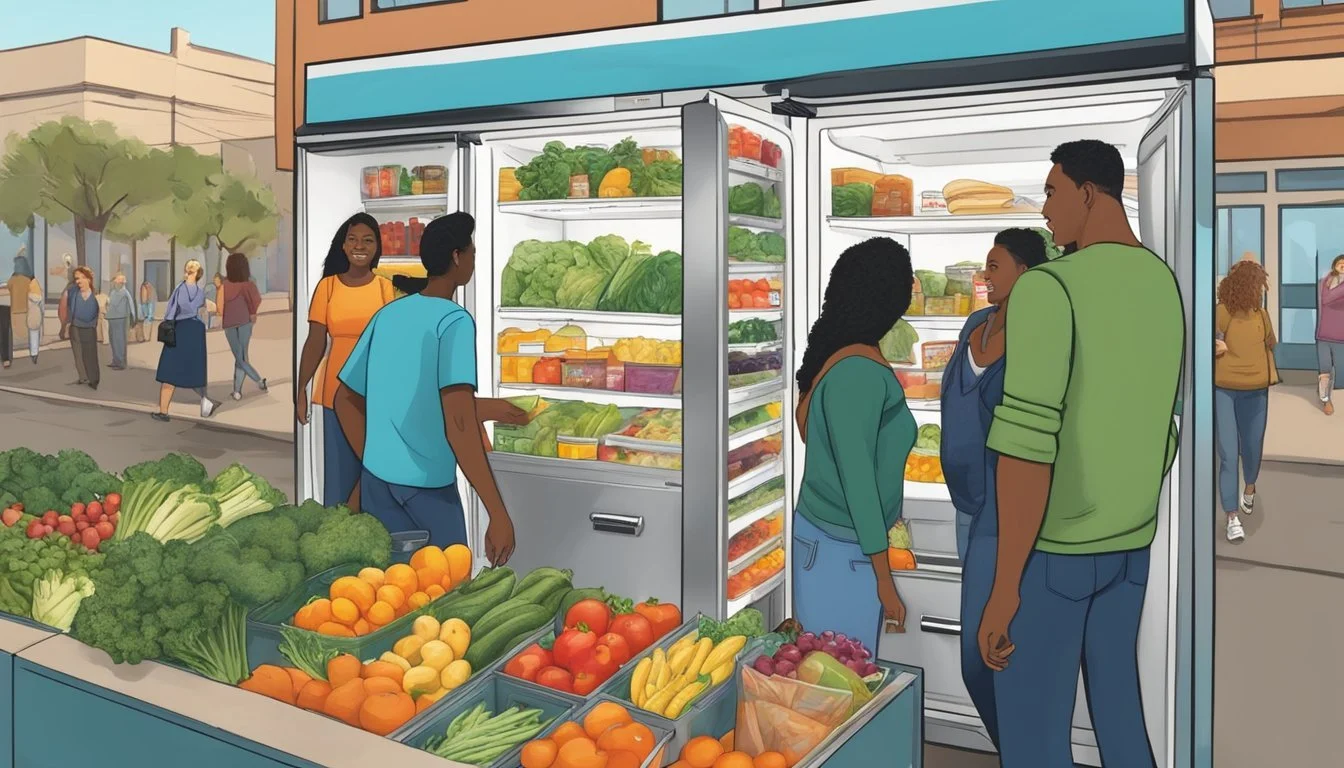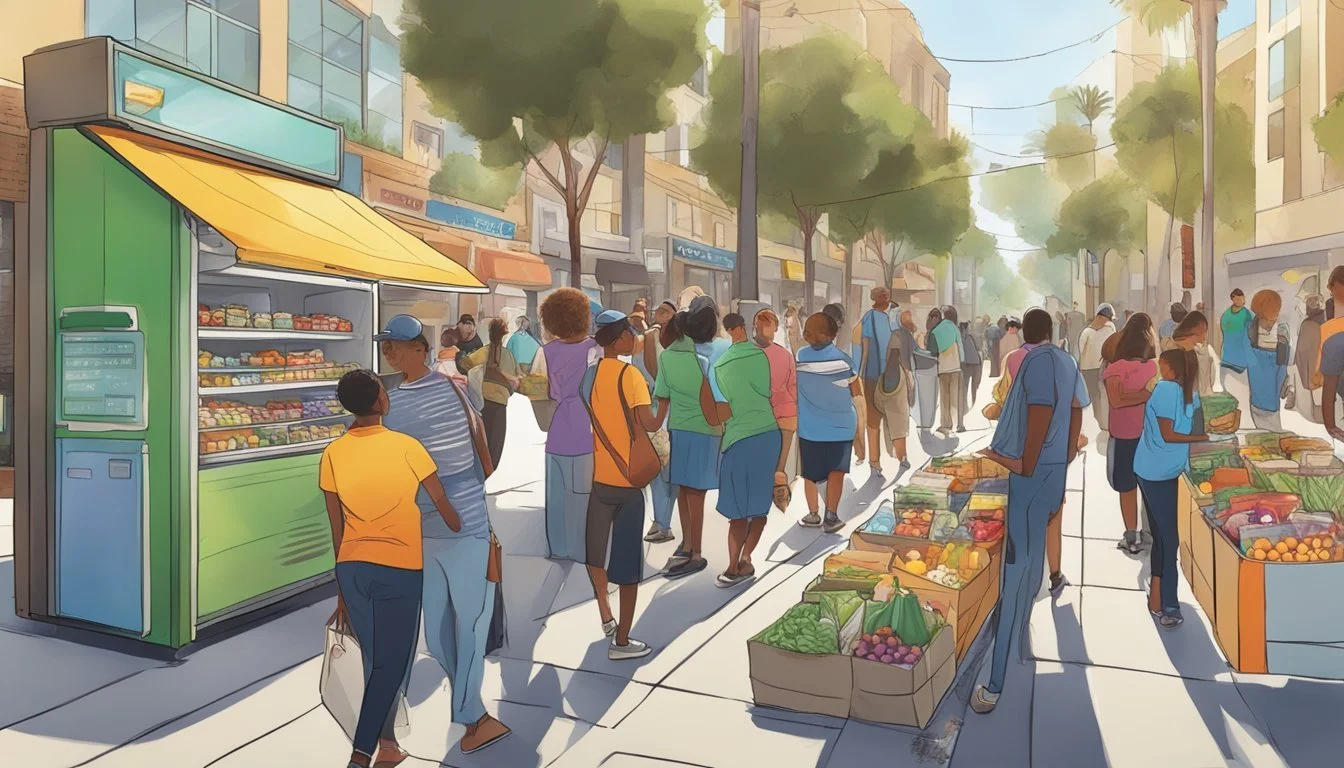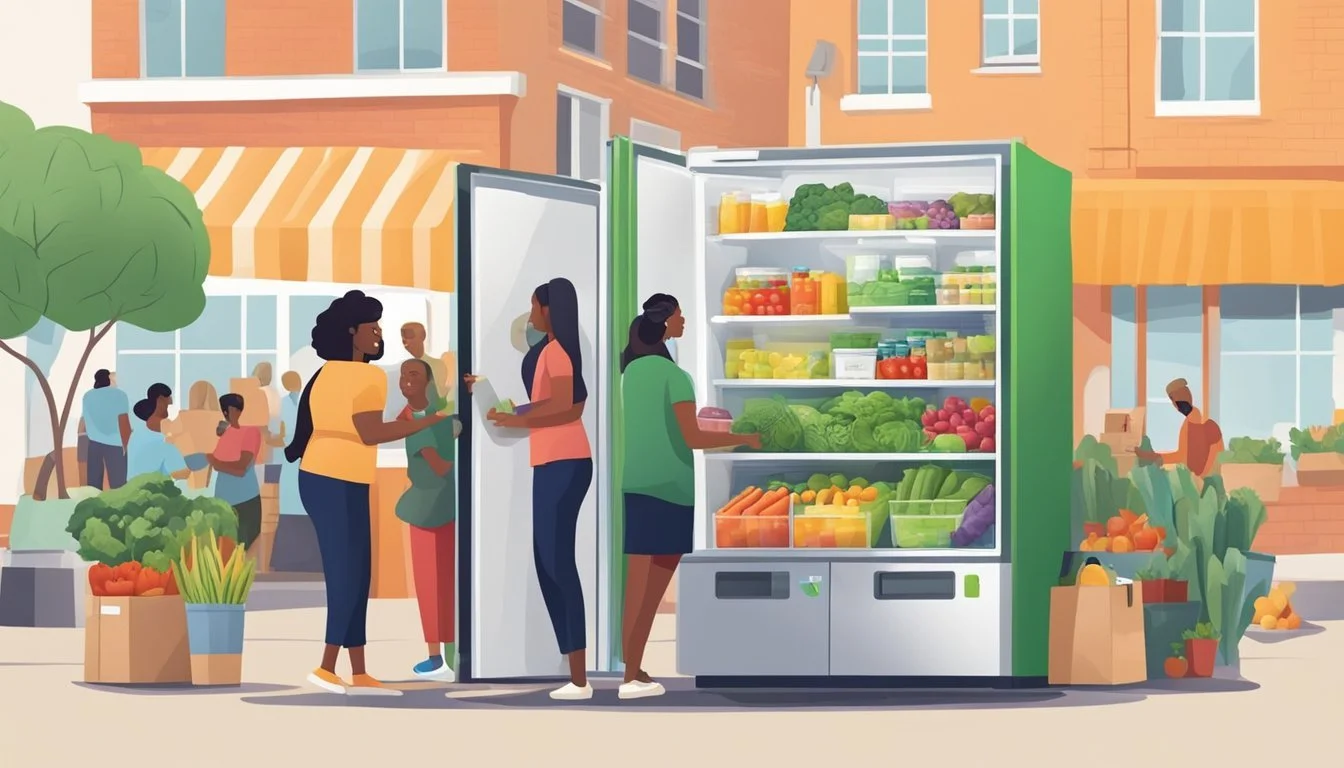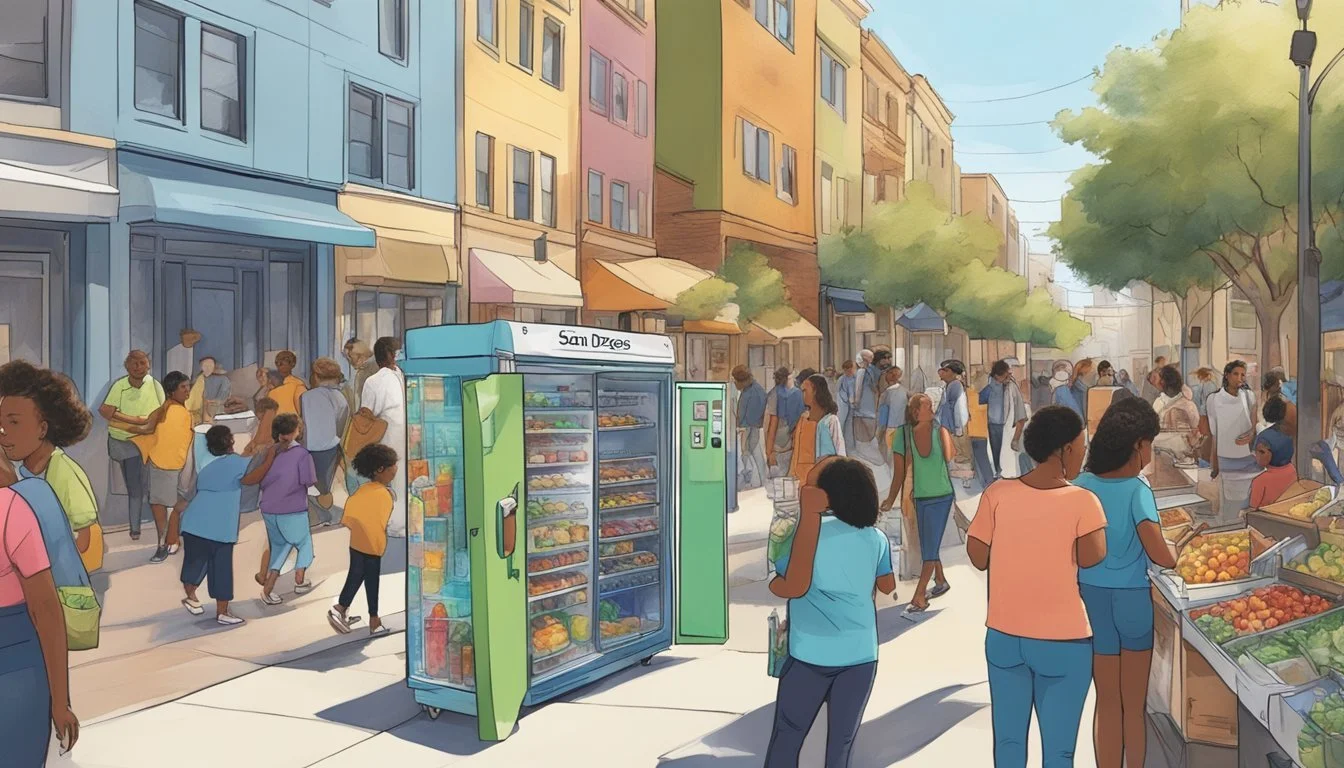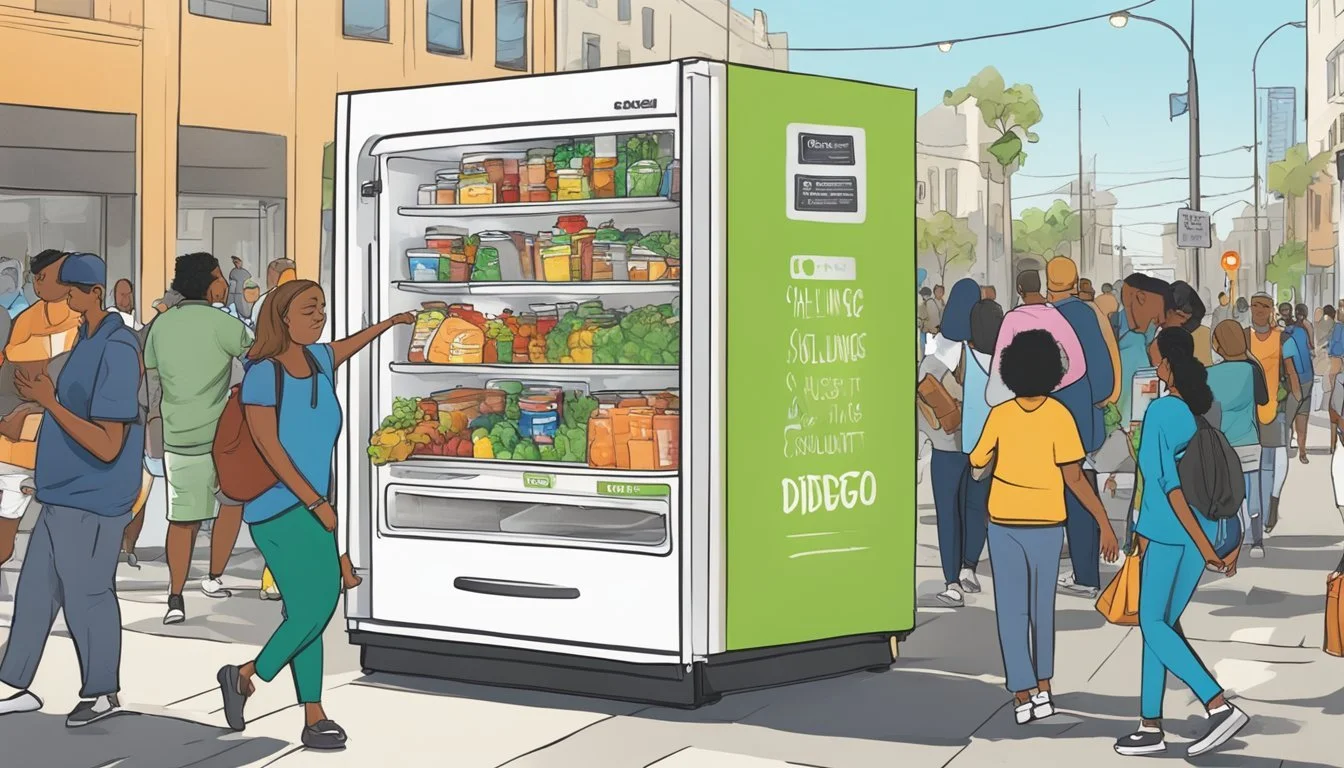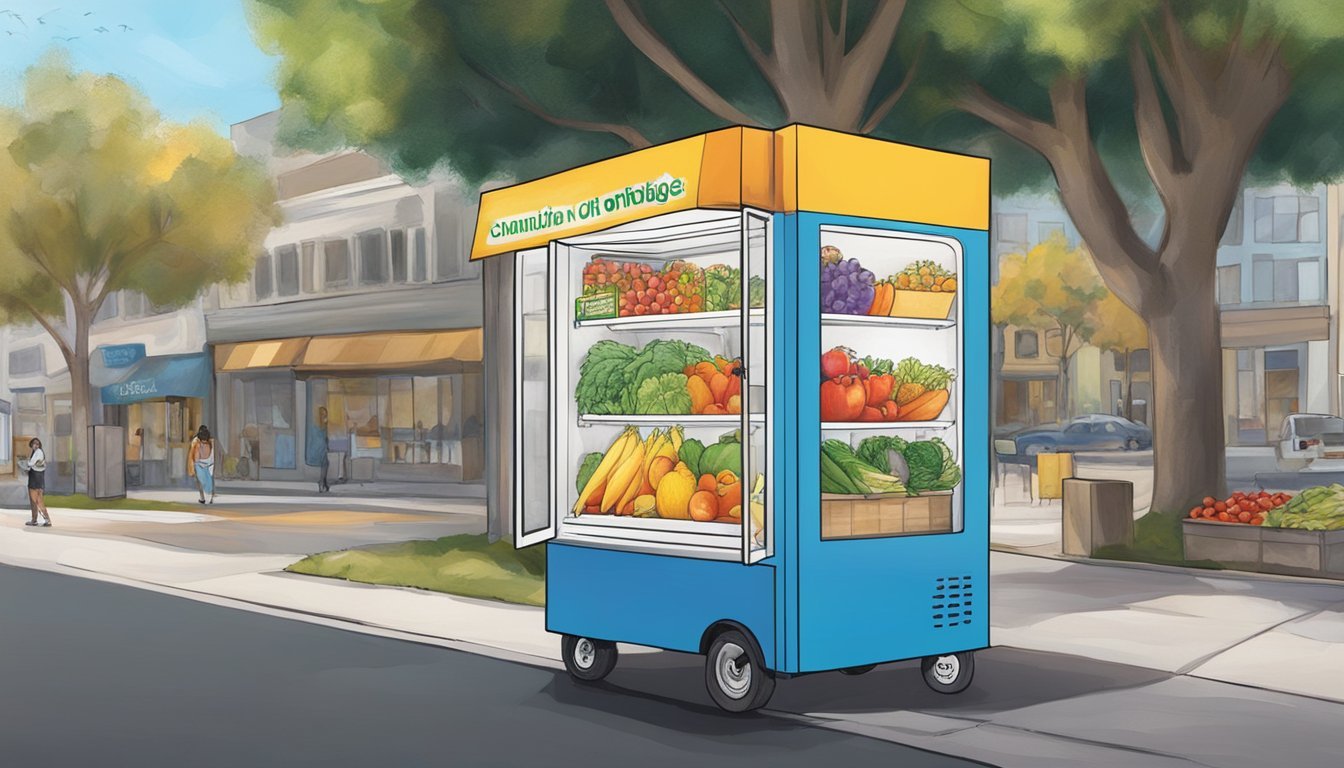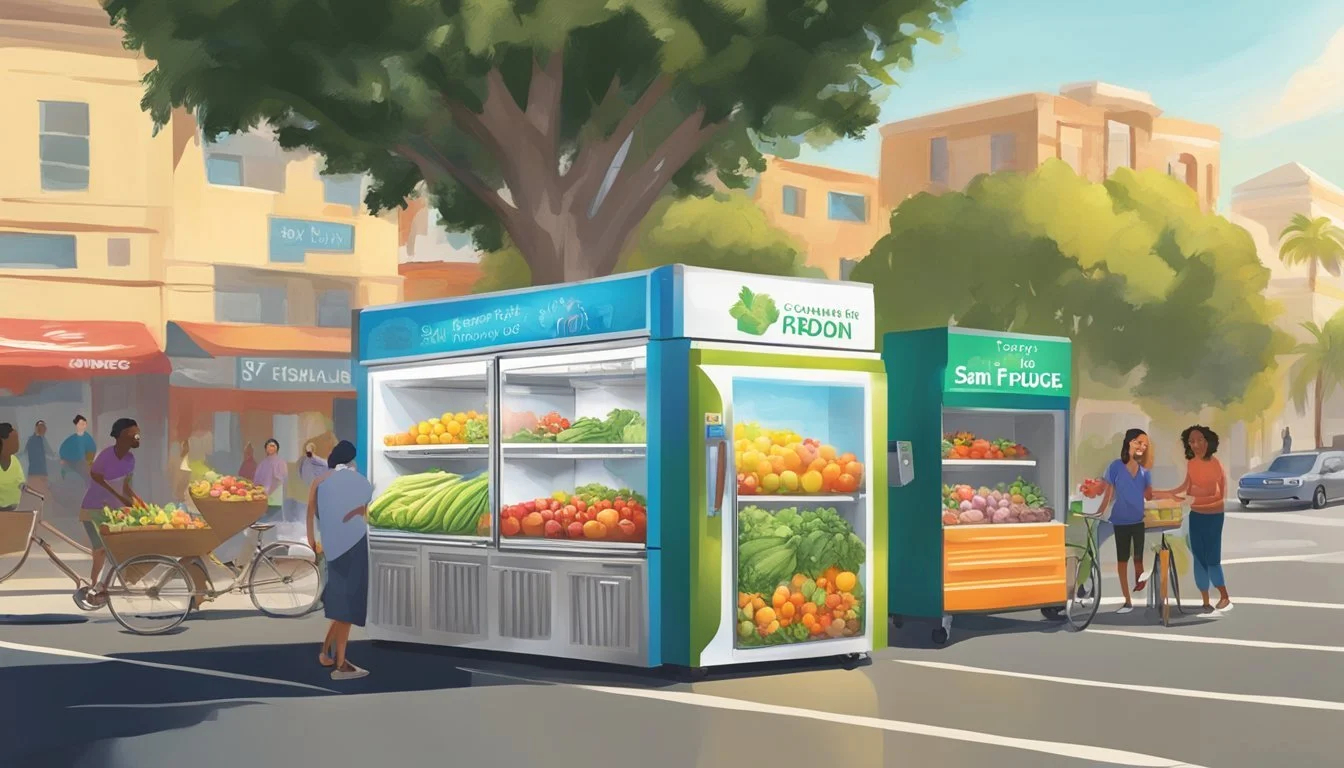San Diego, CA Community Fridge
Nourishing Neighborhoods Together
Community fridges have become a vital resource in San Diego, providing a decentralized approach to food insecurity and fostering a spirit of sharing within various neighborhoods. These communal refrigerators are stocked with surplus food from local businesses and contributions from individuals. They operate on a simple principle: take what you need, leave what you can. This system not only helps those in need of nutritious food but also plays a significant role in reducing food waste and saving money for the community.
In areas such as City Heights, community fridges are managed by local residents with the aim to offer food security and encourage community unity. The accessibility of these fridges allows for food to be available to anyone at any time, removing the barriers that traditional food aid services might have, like limited hours of operation or qualification requirements. The fridges are often placed in easily accessible locations to maximize their use and are maintained by volunteers who ensure the cleanliness and safety of the food provided.
The concept of the community fridge in San Diego has transcended beyond just being a source of free food; it has sparked conversations around food insecurity, food waste, and the local food system. It also tends to become a node of community activity, where stories, art, and ideas are exchanged—further nurturing the relationship among residents and reinforcing the sense of a caring and interconnected community.
Community Fridge Basics
Community fridges in San Diego serve as a collaborative effort to address food insecurity and promote unity by providing free and accessible food to local residents.
What Is a Community Fridge?
A community fridge is a public refrigerator located in a communal space where individuals and businesses can share surplus food with those in need. These fridges facilitate easy access to nutritious food, and act as a resource to combat food waste. They operate on the principle of taking what one needs and leaving what one can, fostering a sense of community and **support.
The Origins of Community Fridges
The concept of community fridges began as a grassroots response to food insecurity and waste. This movement gained momentum as groups recognized the dual benefits of reducing food waste and supporting individuals facing food insecurity. In San Diego, community fridges emerged from a collective desire to provide for neighbors and create a more inclusive and supportive environment for all community members.
Starting a Community Fridge
Setting up a community fridge in San Diego involves a series of structured steps designed to foster local collaboration and comply with regulations. This ensures the initiative is both impactful and sustainable.
Initial Steps to Start a Fridge
To start a community fridge, the founders must first identify a location that's accessible to the community. It's crucial to secure a space with high visibility and foot traffic to maximize the fridge's use and benefits. Additionally, they must source a refrigerator and obtain necessary permissions from property owners.
5 Step Guide for Setting Up
The process of setting up a community fridge can be broken down into distinct steps for clarity and effectiveness:
Forming a Team: Assemble a group of committed members who share the vision of addressing food insecurity.
Location Scouting: Choose a suitable, easily accessible location for the fridge.
Funding and Resources: Secure funding for expenses and build partnerships for ongoing food supply.
Publicity: Create awareness through local media, flyers, and social networks to engage the wider community.
Launch: Begin operations with an event or soft launch to introduce the fridge to the community.
Building a Local Collaborative Network
Collaboration is paramount in the community fridge network. Establishing partnerships with local businesses, non-profits, and citizens enhances the fridge's reach and efficacy. These relationships help to ensure a steady supply of donations and logistical support, making the venture a community-driven effort.
Local Laws and Regulations
Compliance with local laws is non-negotiable. Founders must be well-versed with San Diego's health and safety regulations to ensure the fridge operates within legal confines. This includes obtaining the right permits, ensuring proper food handling, and regular maintenance. Fridge operators should consult with local health departments to navigate the legalities appropriately.
Location and Accessibility
In San Diego, the Community Fridge initiative prioritizes locations that are easy to reach and contribute to the wellbeing of the local community. By selecting public spaces with high visibility and accessibility, these fridges help in tackling food insecurity efficiently.
Choosing Accessible Public Spaces
These fridges are strategically placed in neighborhoods such as City Heights and North Park, ensuring they are within reach for a large number of residents. City Heights, known for its diverse population, has particular emphasis placed on ensuring the community spaces chosen are well-known and can be reached on foot by as many residents as possible. The goal is to create a seamless experience for individuals to both donate and retrieve food items without any barriers.
Support from Local Businesses
Local businesses in San Diego play a crucial role by partnering with the Community Fridge project. These collaborations range from providing surplus food to the fridges to hosting a fridge on-site. The City Heights Community Fridge, for example, benefits from the backing of local enterprises, which contributes not only to the fridge's sustainability but also solidifies the relationship between businesses and the community they serve.
Incorporating into Existing Communities
The fridges are more than just a place to access food—they are integrated into the fabric of the neighborhoods. North Park's Community Fridge, for instance, is not just a standalone appliance; it is part of a larger mutual aid network that is woven into the existing infrastructure of the community. Residents use the space to connect, share, and support one another, which amplifies the impact of the fridges and fosters a stronger sense of community.
Management and Maintenance
The success of the San Diego Community Fridge relies heavily on a structured approach to management and maintenance. Volunteers are at the heart of the operation, ensuring the integrity of shared food resources through careful coordination, adherence to health and safety standards, and maintenance of cleanliness and security.
Volunteer Coordination
Volunteers manage the distribution of surplus food and engage with the local community extensively. Coordination is communicated through platforms such as social media or community boards, where schedules and responsibilities are clearly posted. Tasks include:
Restocking and organizing the fridge contents
Checking for food quality and expiration dates
Health and Safety Requirements
Health and safety are paramount, and volunteers ensure compliance with all local regulations. The fridge operates on principles that guarantee:
Food donated is within its consumption period
The fridge and surrounding area are free from contaminants
Local partnerships, such as with Hangers Cleaners and Laundry, could provide support in maintaining these standards, ensuring all health codes are met.
Ensuring Cleanliness and Security
Cleanliness is a critical aspect that volunteers regularly maintain through:
Daily cleaning schedules to ensure hygiene
Safe handling practices to reduce the risk of contamination
Security measures to protect the food and the users
The community fridge spaces are typically equipped with cleaning supplies and tools for the volunteers to use. Security cameras or regular community patrols could be in place to safeguard against any misuse or vandalism.
Participation and Usage
Community fridges in San Diego have become pivotal in enhancing food security and embodying the spirit of community sharing. Through the collective efforts of neighbors and local organizations, these solidarity fridges operate successfully on principles of honesty and mutual aid.
Guidelines for Use
Community fridges are designed to be easily accessible and operate on a simple honor system. Neighbors are encouraged to adhere to the following:
Take Food: Only take what you need, leaving sufficient resources for others.
Leave Food: Contribute food items that are within their freshness date and safe to consume.
Keep It Clean: Maintain the cleanliness around the pantry area for everyone's health and safety.
Encouraging Community Participation
Local businesses and individuals are instrumental in sustaining community fridges by:
Donating surplus food that would otherwise go to waste.
Volunteering to monitor and maintain the cleanliness of the fridges.
Spreading the word to promote awareness and participation across the community.
The 'Take Some, Leave Some' Philosophy
The success of community fridges relies on a balanced exchange system:
Solidarity Principle: Those who can leave some food are encouraged to do so to support their neighbors.
Honesty Principle: It operates on trust, assuming that people will take food honestly according to their needs.
Mutual Benefit: Both contributors and beneficiaries find value in community fridges, bridging social divides and fostering ties.
Contribution and Support
The San Diego Community Fridge initiative thrives on the support and donations from local businesses, individuals, and groups. These contributions not only help to reduce waste but also ensure a steady supply of food and vital supplies to those in need.
Donating Food and Supplies
Local community members can contribute surplus food, such as milk and fruits, to the community fridges positioned throughout San Diego. These yellow fridges are easily recognizable and accessible for food donations. Contributors are advised to ensure that the food is fresh and safe for consumption. In addition to food, essential items such as utensils, hand sanitizer, and personal protective equipment (PPE) are also welcomed to assist with health and safety.
Local Business Involvement
San Diego businesses play a crucial role by donating surplus food items, thus aiding in the effort to reduce waste. These contributions not only support community well-being but also reflect a commitment to sustainability. By partnering with the community fridge network, businesses highlight their civic responsibility and encourage others to do the same.
Individual and Group Donations
Both individuals and community groups can make donations to support the fridge network. Monetary contributions are used for maintenance and expansion of the fridges, ensuring they remain a reliable resource for those who depend on them. Additionally, volunteers are essential for the organization and distribution of donated items, and for keeping the fridges clean and well-stocked.
Impact of Community Fridges
Community fridges in San Diego, CA, have emerged as critical resources in addressing pressing social issues. They play a significant role in reducing food insecurity, preventing food waste, and offering support to disadvantaged populations across the city.
Reducing Food Insecurity
Community fridges directly contribute to alleviating hunger among City Heights residents and beyond. By providing free access to food 24/7, these refrigerators ensure that individuals and families struggling to afford groceries can obtain nutritious options. This is particularly valuable in areas with high rates of unemployment or where people do not qualify for government assistance programs.
Preventing Food Waste
San Diego's community fridges also tackle the environmental issue of food waste. Local businesses and individuals donate surplus food, which is then shared with the community. The initiative not only redistributes food that would otherwise go to waste but also promotes sustainability and conscious consumption.
Supporting Disadvantaged Populations
The presence of community fridges is a boon to disadvantaged groups such as the homeless, who may lack the means to store and prepare food. By offering ready-to-eat meals and fresh produce, these community-driven projects provide a reliable food source. They also foster a sense of community by encouraging residents to support each other through donations and volunteer work.
Community Fridge Networks Globally
Community fridges have emerged as a solution to food insecurity and food waste around the globe. They act as nodes connecting surplus food with those in need, fostering community spirit in the process.
Examples from Around the World
In Spain, local communities have embraced the concept, creating access points for free food and fostering connections among residents. They often partner with local businesses to keep the fridges stocked.
Germany has also seen a rise in community fridges, or 'Fair-Teiler', as they are sometimes known. They serve not only to alleviate hunger but also to reduce food waste, aligning with the country's strong environmental values.
The UK hosts a notable network, 'The Community Fridge Network' launched by Hubbub, which has been instrumental in setting up new fridges and offering support across the region. This collaborative effort emphasizes the sharing of resources and experiences.
Across the Irish Sea, Ireland has experienced similar growth with community fridges, facilitated by support networks designed to spread knowledge and assist with the logistical challenges of running a fridge.
Lessons from International Networks
One core lesson from various international networks is the importance of adapting to local circumstances. Each fridge must be sensitive to its community's unique needs, like dietary preferences and local food availability.
The Community Fridge Network in the UK, for example, shares valuable insights on operating fridges safely and effectively. By sharing these experiences, new fridges in places like the US can bypass common initial obstacles.
US fridges have adapted by creating structured systems that ensure food safety and continuous operation. Monitoring the fridges for cleanliness and stock levels ensures that they remain safe and inviting spaces for community members to use.
Challenges and Solutions
The Community Fridge initiative in San Diego encounters specific challenges ranging from navigating local regulations to ensuring public health and safety. These challenges are met with adaptive solutions that maintain the integrity and continuity of the community aid programs, particularly in light of the COVID-19 pandemic.
Addressing Legal Hurdles
Local laws and ordinances present initial barriers for community fridges. Organizers must ensure compliance with county health regulations and food safety standards. Solution: They engage with local health departments to adhere to the rules, such as obtaining necessary permits and ensuring the fridge is located in an area zoned for public food distribution.
Maintaining Safety and Trust
Health and safety are of paramount importance. The community must trust that the food provided is safe to consume. Solution: Regular checks are implemented to remove rotten or unwanted items, and volunteers are trained in safe food handling. Fridges are regularly cleaned and maintained to prevent health hazards, fostering a sense of reliability and trust within the community.
Adapting to Pandemic Conditions
The COVID-19 pandemic required the community fridge organizers to re-evaluate their model to prevent virus transmission. Solution: They introduced safety protocols, such as social distancing markers, mandatory mask usage, and frequent sanitization of touchpoints. Additionally, they adapt to changing conditions, such as lockdowns and supply shortages, to ensure that community support remains uninterrupted.
Supporting Resources
The San Diego Community Fridge initiative is supported by a variety of resources designed to facilitate its operations, engage volunteers, and inform residents. These materials are essential for the accessibility and continuity of the community fridges.
Educational Materials
To ensure effective use of the Community Fridge, educational materials are provided. These resources help residents learn how to donate and take food safely and hygienically. They also include:
Access Guidelines: Clear instructions on how to access the fridge, list of acceptable items, and hygiene tips.
Food Safety Information: Flyers and handouts detailing safe food handling and storage practices.
Operational Checklists
Operational checklists are vital to maintain the fridge's day-to-day functionality. They serve an important role in guiding the volunteers who manage the fridges. Elements of operational checklists include:
Daily Maintenance Checks: Ensuring the fridge is clean and at the correct temperature.
Inventory Tracking: Regular recording of food stock, to manage supply and demand.
Community Outreach
Successful community outreach ensures the fridge is both well-stocked and utilized by those in need. Strategies include:
Volunteer Coordination: Assigning tasks and shifts to volunteers for the smooth operation of the fridge.
Resident Awareness Programs: Using social media, flyers, and community events to inform local residents about the fridge location and how they can contribute or benefit from it.
Case Studies
In San Diego, the community fridge initiative showcases the power of local engagement and cooperation in tackling food insecurity. Two subsections on success stories and lessons learned illuminate the project's impact and development.
Community Fridge Success Stories
In City Heights, a once simple yellow refrigerator has transcended its humble function to become a community beacon where residents often access free, nourishing food. Volunteers have played a pivotal role in this success, ensuring the fridge is stocked and maintained. The People's Fridge in San Diego exemplifies this spirit of sharing and solidarity, illustrating that such initiatives can thrive with community backing.
Impact:
Serves dozens daily
Encourages community cooperation
Provides access to nutritious food
Expansion:
Inspired more installations like Delhi People’s Fridge
Plans to scale up within the area
Lessons Learned from San Diego
San Diego's experience with community fridges has shed light on effective strategies for community-led food security. First, the collaboration between local businesses and individuals has been essential, with the sharing of surplus food reducing both waste and hunger. Second, the visibility and accessibility of these fridges are critical; placing them in central locations facilitates easier access for those in need.
Strategies:
Engage local businesses: Their involvement is crucial for a sustainable supply of food.
Accessible Locations: Ensure fridges are easily reachable by the intended beneficiaries.
Challenges:
Maintaining a consistent food supply
Balancing food safety with open access
Future Directions
The San Diego Community Fridge initiative continues to evolve, with an emphasis on reducing waste and a focus on increasing the collaborative network known as 'freedge'. The movement's growth and development hinge on innovations and the expansion of access within the network.
Innovations in the Movement
In the pursuit of cutting down food waste and ensuring the efficient distribution of surplus food, the introduction of new technologies and methods is imminent. Innovations such as smart tracking systems can optimize food rotation and monitor inventory in real-time, ensuring that the most perishable items are used first. Moreover, the use of smartphone apps could enable residents to check the availability of items in community fridges, thus improving the user experience and decreasing unnecessary trips.
Expanding Access and Networks
The expansion of the community fridge network is critical. Collaborative networks between food donors, local businesses, and community fridges ensure a consistent supply of surplus food. By broadening the network
More neighborhoods can benefit from the initiative,
A greater diversity of food can be offered, and
Public awareness can be amplified through education and community engagement.
Efforts to secure partnerships with local farms and grocery stores could further stabilize the flow of surplus items, ensuring that these community points remain stocked. The community fridge network, by working in tandem with other local hunger relief and environmental organizations, aims to create a comprehensive approach to food insecurity and environmental sustainability.
Conclusion
Community fridges have emerged as a proactive approach to address food insecurity in San Diego. These public refrigerators offer free food to those in need, promoting a spirit of sharing and sustainability within the community. Businesses and individuals contribute surplus food, effectively reducing waste while helping to connect members of the community.
San Diego's embrace of the community fridge initiative demonstrates a commitment to battling hunger and fostering community spirit. Despite challenges, such as regulatory pushback or logistical hurdles, the collective efforts in supporting and maintaining these fridges exemplify the city's solidarity.
Table: Impact of Community Fridges in San Diego
Aspect Description Food Security Increased access to food for residents in need. Community Bonding Encouraged unity and support among community members. Waste Reduction Decreased food waste through redistribution.
The success of community fridges in San Diego can be seen in the daily reliance of residents on these resources, which, in turn, inspires further communal endeavors. This initiative is a testament to the city's resilience and innovative spirit in times of hardship, such as the COVID-19 pandemic.


